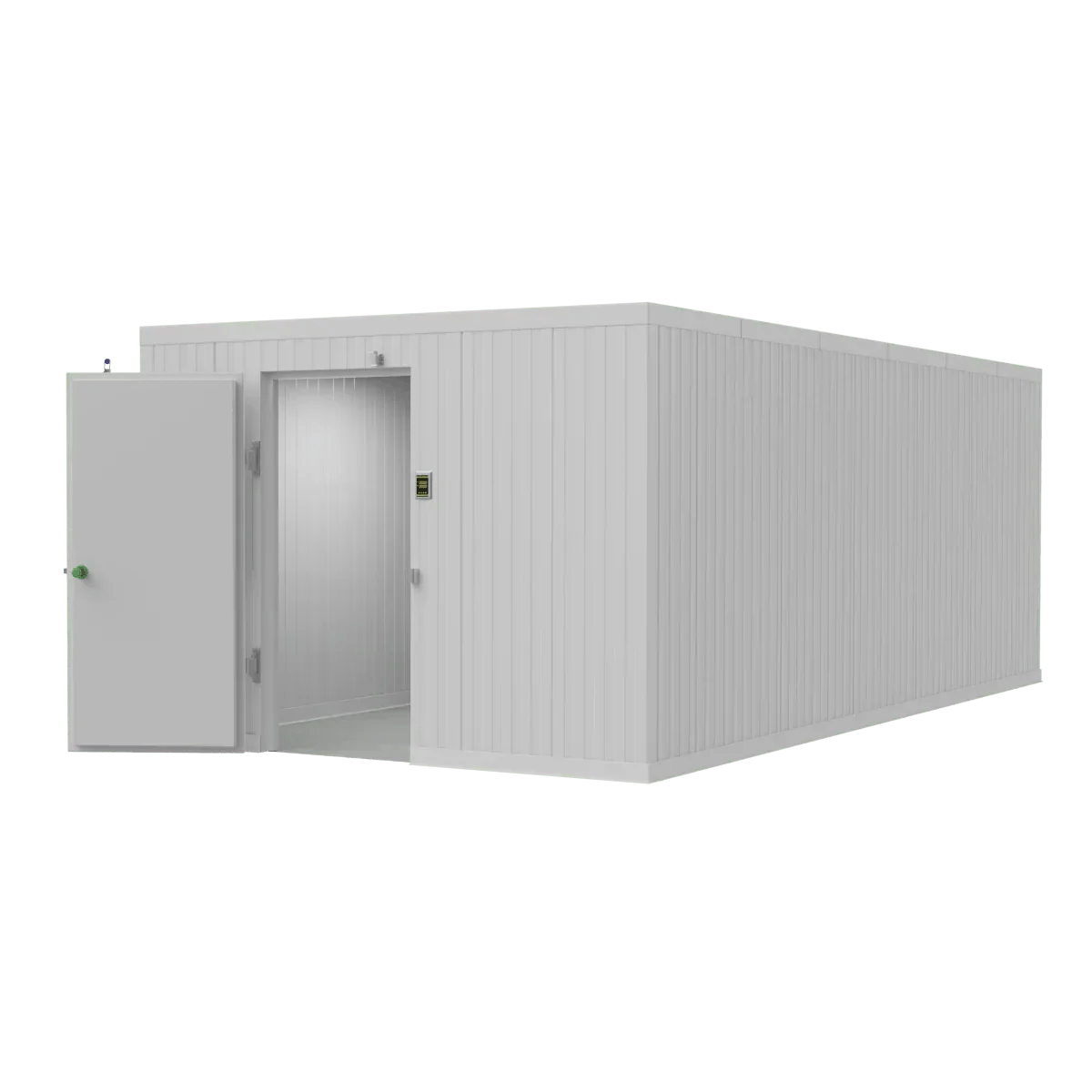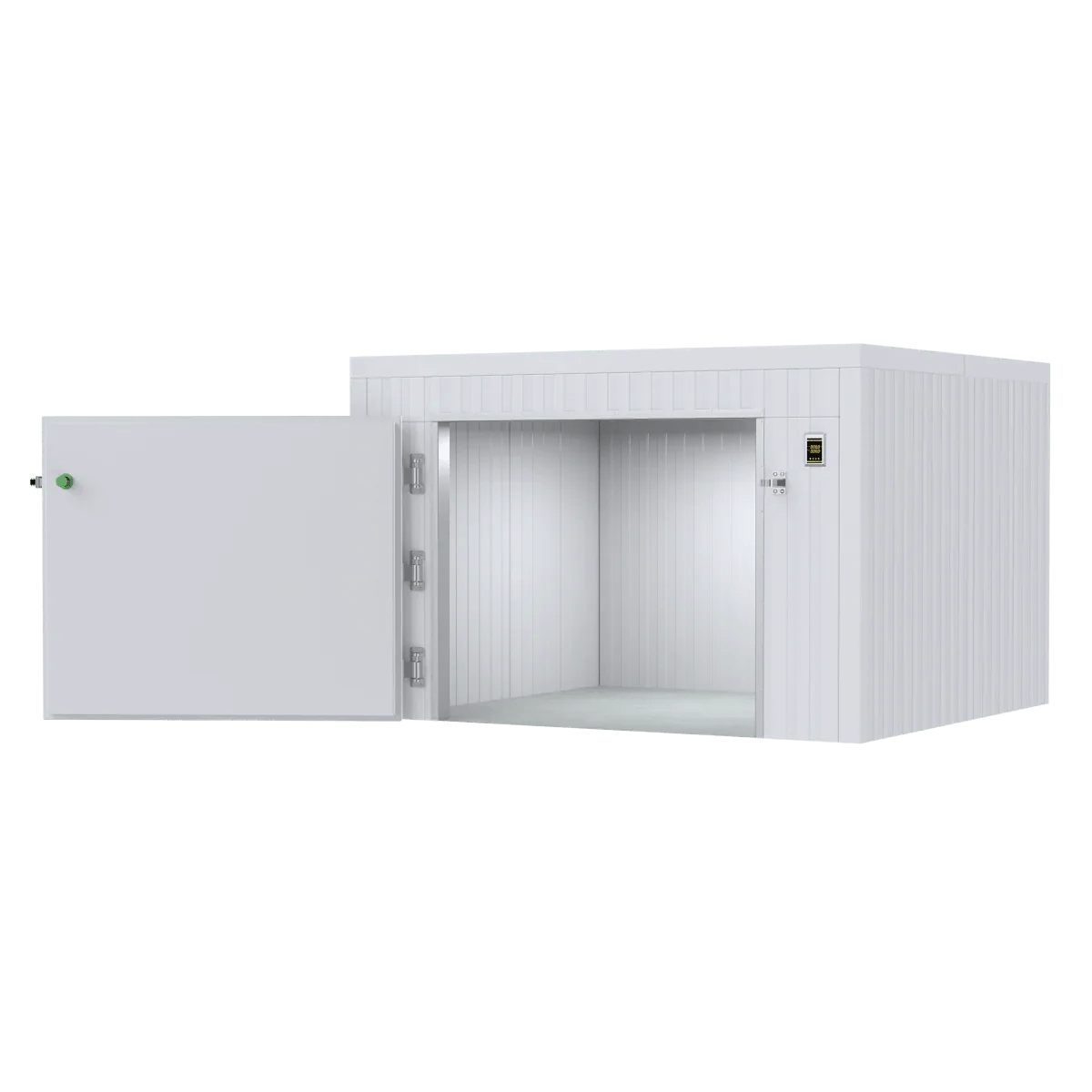Why Antique Cooling Tables Matter in Funeral History
An antique cooling table was a wooden platform used in 19th and early 20th-century home funerals to preserve bodies before burial. These folding tables used ice blocks placed beneath perforated or cane-latticed surfaces to slow decomposition during the days-long mourning period common in Victorian homes.
Quick Facts About Antique Cooling Tables:
- Time Period: 1880s-1940s (peak usage)
- Primary Use: Body preservation with ice cooling in home parlors
- Key Features: Folding design, cane lattice or perforated top, drainage system
- Typical Size: 73-76" long × 19" wide × 16-25" tall
- Major Maker: B.F. Gleason of Brockport, New York (patents 1881-1886)
- Current Value: $300-$600 (common condition) to $5,000+ (rare examples)
Before modern funeral homes and refrigeration, families held funerals in their own parlors. As one collector noted about their antique find: "This piece of furniture may be one of the strangest objects that I have ever encountered, and definitely the strangest that I own." These tables represent a fascinating glimpse into how Americans once dealt with death at home.
The portable design allowed traveling morticians to bring preservation equipment directly to grieving families. Ice placed under the latticed surface created a cooling chamber that could maintain a body for several days of viewing and mourning rituals.
I'm Mortuary Cooler, a national-level mortuary cooler supplier with experience in both modern and historical body preservation equipment. My work with funeral homes across America has given me deep insight into how antique cooling table designs evolved into today's advanced refrigeration systems.
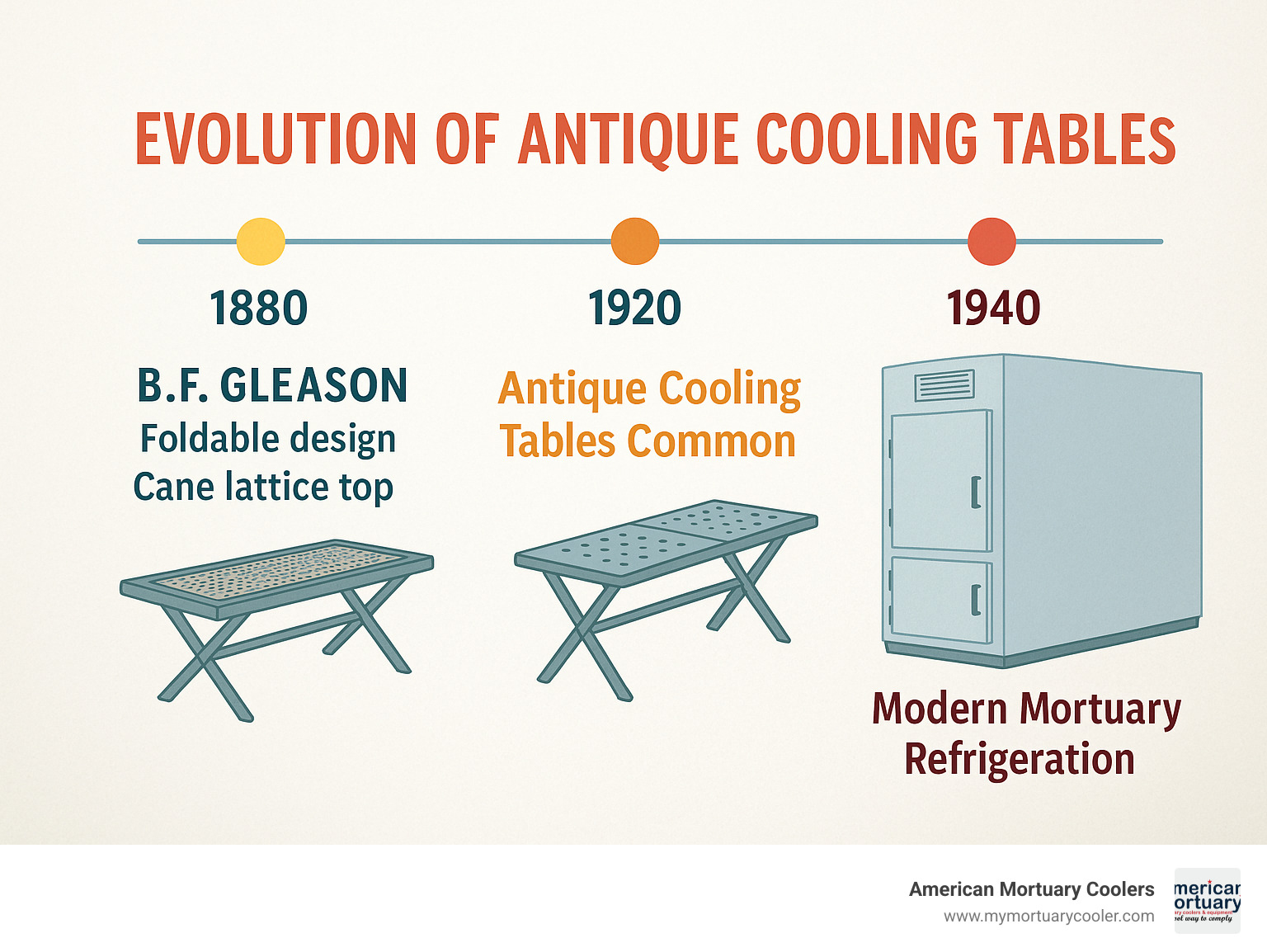
Key antique cooling table vocabulary:
What Is an Antique Cooling Table? Origins & Funeral Customs
Picture a Victorian family parlor transformed into a place of mourning. In the center sits an unusual piece of furniture - an antique cooling table that would serve as the heart of a home funeral. These remarkable devices changed how 19th-century families said goodbye to their loved ones.
An antique cooling table was essentially a wooden platform designed to preserve bodies using ice cooling. When someone died at home (which was common in the 1800s), families needed a way to keep the body presentable for the traditional multi-day wake. Without any refrigeration or modern embalming, this was a real challenge.
The genius was in the design. These tables featured oak frames topped with cane lattice or perforated pine surfaces. Ice blocks went underneath, creating a natural cooling chamber that could keep a body preserved for several days. This gave families time to follow Victorian mourning customs, which often included elaborate viewing rituals and long visitation periods.
B.F. Gleason of Brockport, New York became the most famous name in cooling tables. His company held patents from 1881 to 1886 and mass-produced these tables across America. Suddenly, even rural undertakers could offer professional-grade body preservation without expensive equipment or specialized training.
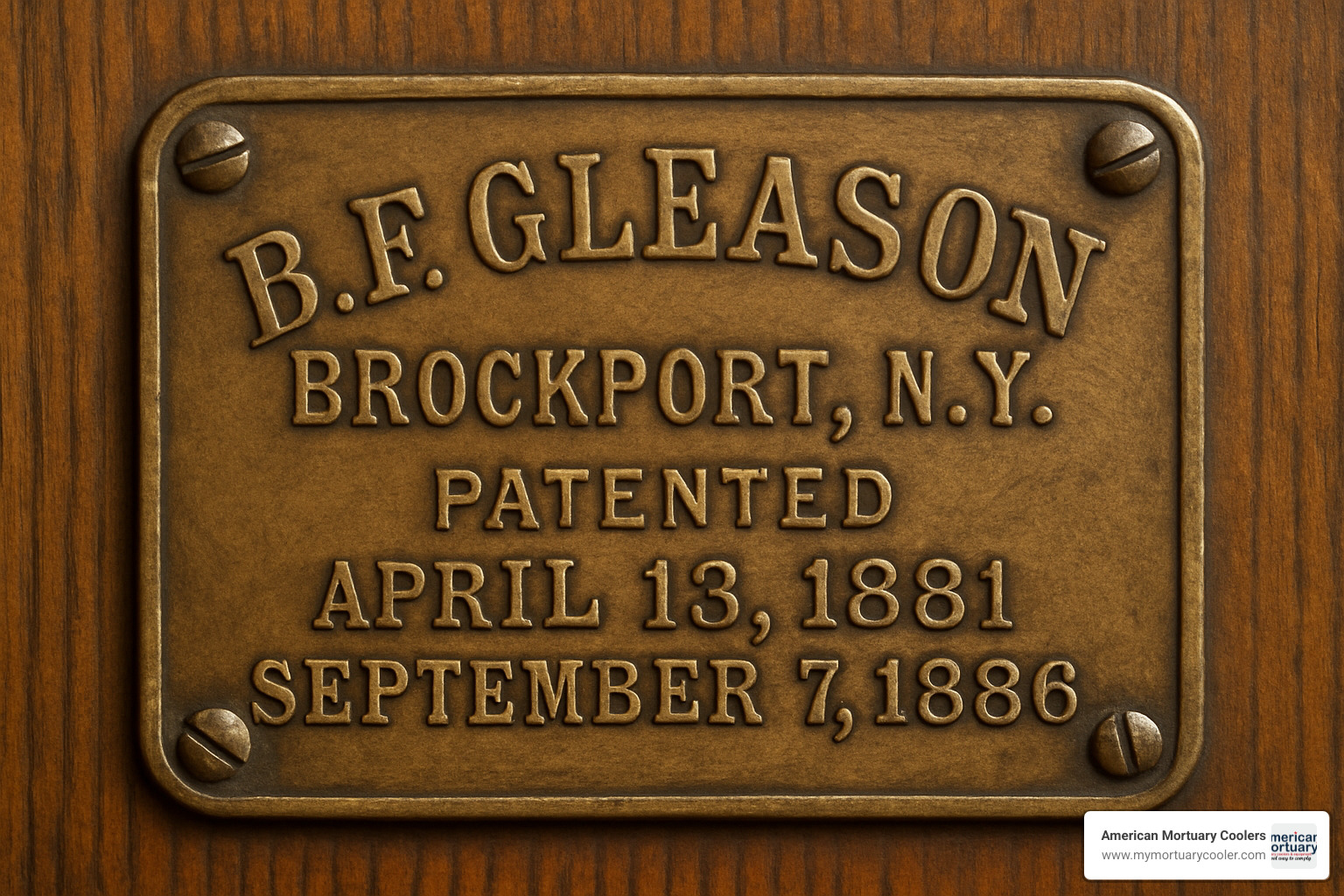
The portability factor was huge. These tables folded up for easy transport, meaning a single mortician could serve multiple communities. He'd arrive at a home with his folding cooling table, set it up in the parlor, and provide families with dignified funeral services right in their own homes.
The Shift from Corpse Coolers to Cooling Tables
Before cooling tables became the standard, morticians struggled with primitive "corpse coolers" - basically ice-filled caskets that were difficult to maintain. These early systems required constant ice casket service calls just to drain melted water and add fresh ice.
The Civil War changed everything by advancing embalming techniques. Doctors like Thomas Holmes pioneered modern preservation methods to transport fallen soldiers home to their families. But civilian funeral practices moved much slower - most families still preferred traditional home funerals well into the 1880s.
Cooling tables offered the perfect compromise. They gave professional morticians reliable results without requiring the specialized skills needed for embalming. Many families also preferred them because they seemed more natural and respectful than the newer embalming process.
The rise of cooling tables marked a turning point in American funeral customs. They bridged the gap between old-fashioned home care and the professional funeral industry that was just beginning to emerge. For about 60 years, these ingenious tables helped families honor their dead with dignity and tradition.
Anatomy of an Antique Cooling Table: Design, Materials, Mechanics
When you examine an authentic antique cooling table, you're looking at a masterpiece of practical engineering disguised as simple parlor furniture. These tables weren't just functional - they were carefully crafted to blend into Victorian homes while performing their solemn duty.
The frame construction tells the whole story. Most genuine cooling tables featured solid oak frames chosen specifically for their ability to withstand moisture and heavy use. Oak didn't warp when exposed to melting ice, and it could support the weight of an adult body without creaking or flexing.
The tabletop design is where things get interesting. You'll typically find either cane lattice work or perforated pine boards, both engineered to maximize airflow while providing adequate support. Here's a fascinating detail: manufacturers like Gleason didn't randomly drill those holes. They actually arranged the perforations to spell out their company names and patent dates - a clever form of advertising that doubled as authentication.
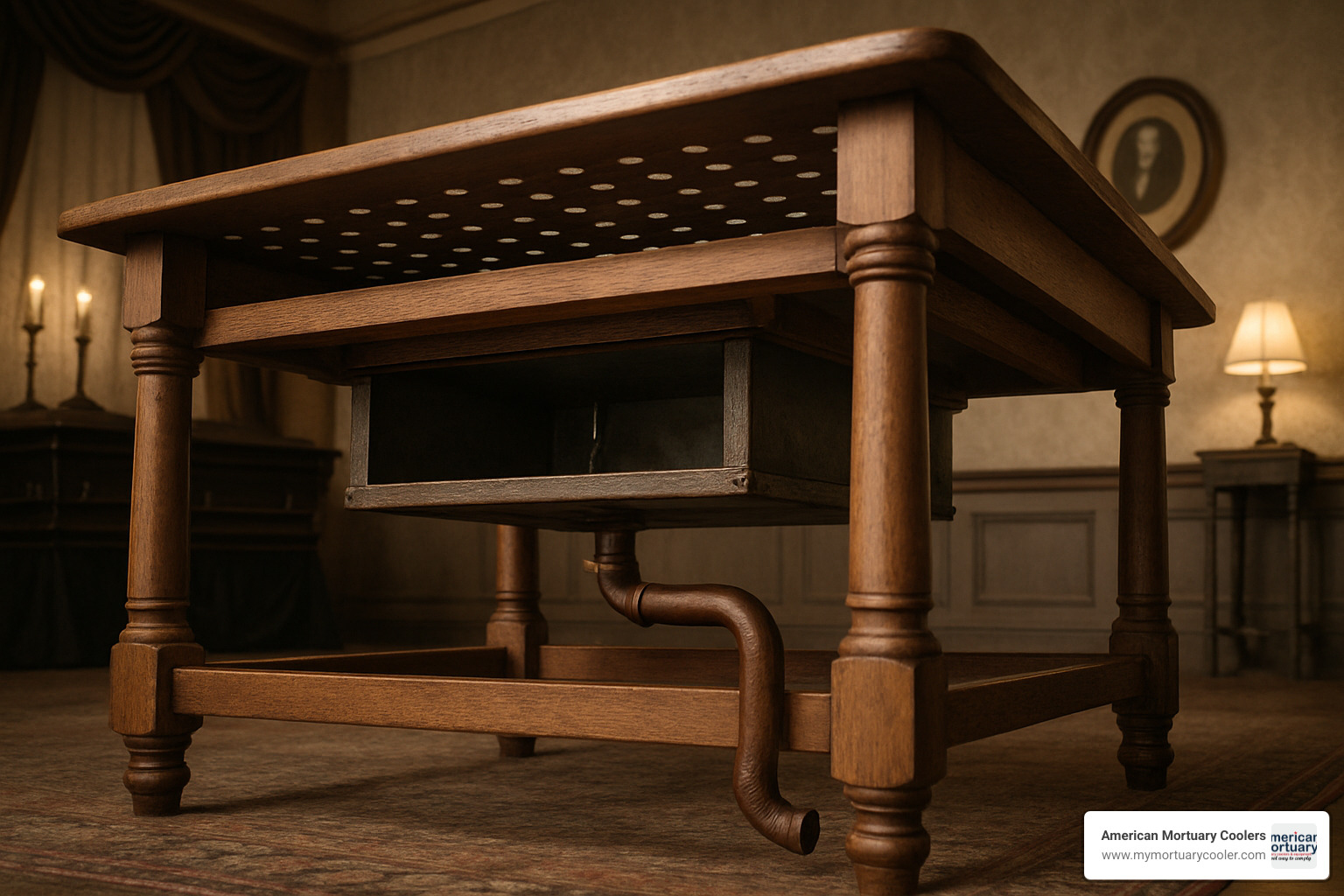
Standard adult tables measured a consistent 73-76 inches long by 19 inches wide, with heights ranging from 16-25 inches depending on the manufacturer. The dimensions weren't arbitrary - they were sized to fit through standard doorways while accommodating adults of various heights.
Sadly, manufacturers also produced child-sized variants around 42 inches long by 15 inches wide. These smaller tables reflect the harsh reality of 19th-century life, when child mortality rates made such equipment necessary for many families.
The folding legs were perhaps the most ingenious feature. Most tables collapsed to roughly half their open length - that 73-inch table might fold down to just 39 inches. Hidden brass handles positioned for proper weight distribution meant a traveling mortician could carry the folded table like an oversized briefcase.
Drainage slots carved around the table edges weren't decorative - they channeled melted ice water away from the body and into collection vessels below. This prevented water damage to expensive family carpets and furniture while maintaining sanitary conditions throughout the viewing period.
How the Ice Cooling System Worked
The physics behind these tables were neatly simple. Large ice blocks placed in the compartment beneath the perforated surface created a natural cooling chamber. As ice melted, cold air rose through the holes or cane lattice, maintaining temperatures around 40-50 degrees Fahrenheit.
Wicking linens placed over the lattice served a dual purpose. They absorbed condensation while providing additional cooling through evaporation - the same principle that makes you feel cold when you step out of a swimming pool.
The system could maintain effective preservation for 3-5 days with proper ice replenishment. This gave families adequate time for the elaborate mourning rituals that Victorian society expected, including extended visitation periods and elaborate funeral preparations.
Condensation runoff was carefully managed through the drainage system. The slight slope built into the table surface ensured that melted ice water flowed toward the collection channels rather than pooling on the surface.
Portability Matters: Folding Frames & Traveling Morticians
The folding design wasn't just convenient - it was the foundation of 19th-century funeral service. Most morticians served multiple small towns, loading their equipment onto wagons or trains to reach families in need.
A typical cooling table opened to 73" × 19" but folded to just 39" × 6" - a change that made the difference between practical transport and impossible bulk. The brass handles weren't decorative touches but carefully engineered lifting points that balanced the weight properly.
This portability revolutionized rural funeral service. Morticians could essentially create portable mortuaries that set up in any family parlor within hours. No longer did families have to transport their deceased to distant funeral establishments or rely on primitive preservation methods.
The train and horse cart transport capabilities meant professional funeral services reached even the most remote communities. A single mortician with a folding cooling table could serve territories spanning hundreds of miles.
For more insight into how these portable designs evolved into modern equipment, you can explore our comprehensive guide to folding mortuary tables to see how the principles pioneered in antique cooling tables continue to influence funeral equipment design today.
Identifying & Authenticating an Antique Cooling Table
Finding an authentic antique cooling table can feel like finding treasure in your grandmother's barn. But before you get too excited about that folding table gathering dust, you'll need to know what to look for. After years of evaluating these fascinating pieces, I've learned that certain details always separate the real deal from clever reproductions or misidentified furniture.
The maker's mark is your best friend when authenticating these pieces. Look for a small brass plaque riveted to the frame - this is like finding the original birth certificate. Authentic B.F. Gleason tables proudly display those magic patent dates: April 13, 1881 and September 7, 1886. The plaque should also show "Brockport, New York" and feel solidly attached, not like something added later.
Run your hands over the construction quality. Original tables used mortise-and-tenon joinery - those strong interlocking wooden joints that craftsmen have used for centuries. The hardware should be hand-forged iron or brass, not shiny modern screws. Real antique wood has a natural patina that develops over decades, creating subtle color variations that reproduction makers just can't fake convincingly.
The cane lattice work tells its own story too. Authentic weaving shows natural wear patterns where bodies once rested, and you might even find period-appropriate repairs using matching materials. Modern reproductions often use synthetic materials or weaving that looks too perfect and uniform.
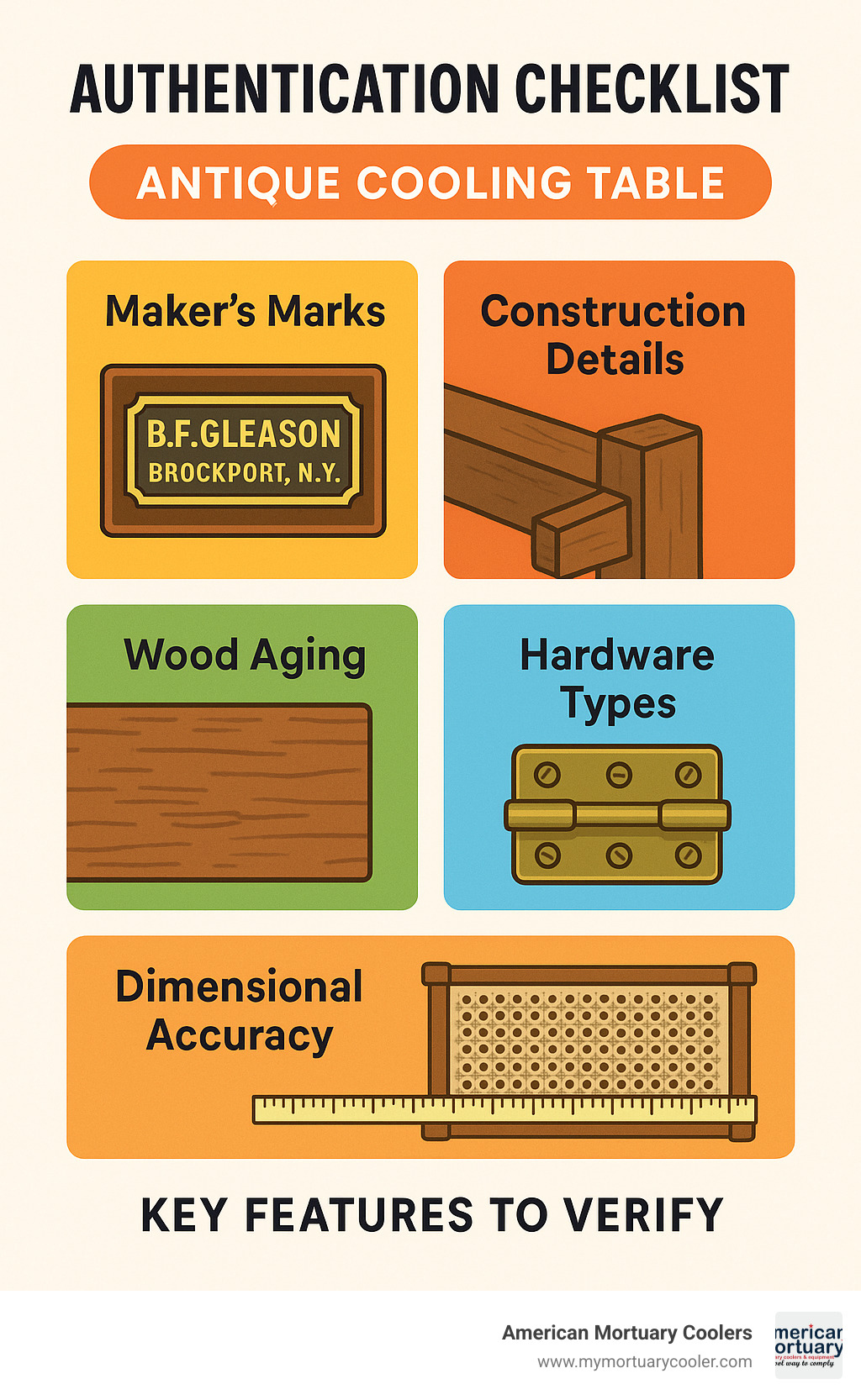
Key Manufacturers and Patents to Know
While B.F. Gleason dominated the cooling table market, he wasn't the only game in town. H.A. Wynkoop created similar designs that often featured slightly different folding mechanisms or decorative touches. Local carpenters also crafted custom tables for their communities, though these handmade pieces lack the standardized features you'll find on mass-produced models.
Those 1880s patent drawings reveal fascinating details about how these designs evolved. Early models used simple perforated boards, but later versions got fancy with sophisticated drainage systems and adjustable components. Understanding this timeline helps you date a specific piece accurately - it's like reading the table's family tree.
Regional differences add another layer to the authentication puzzle. Southern manufacturers sometimes used different wood species based on what grew locally, while Western makers built their tables extra sturdy for rougher transport conditions. These regional quirks can help establish where an unmarked piece originated.
For deeper insights into how these designs developed over time, check out our detailed exploration of the function and design of antique cooling tables.
Spot the Impostor: Cooling Table vs Embalming Table vs Military Cot
Here's where things get tricky - lots of similar-looking furniture gets mistaken for antique cooling tables. Military field beds are common imposters because they fold and they're about the right size. But they're missing the perforated tops and drainage systems that made cooling tables actually work for their intended purpose.
Embalming tables present another identification challenge. These feature solid zinc or porcelain tops without any airflow holes, plus built-in drainage channels around the edges. They were designed for fluid embalming procedures, not ice cooling - completely different technology for a different era.
Pay attention to height adjustment mechanisms too. Cooling tables maintained fixed heights that were carefully calculated for optimal ice cooling efficiency. Embalming tables often had adjustable legs or tilting mechanisms to accommodate different procedures and operator preferences.
Watch out for those battlefield myths that sellers sometimes spin. Some claim their pieces saw action in the Civil War, but the technology didn't exist until the 1880s. Those patent dates don't lie - if you see 1881 or 1886 on the maker's mark, that table came decades after Appomattox.
The airflow holes are the real giveaway. If there aren't any holes or lattice work designed to let cold air circulate upward, you're probably looking at something else entirely. These tables had one job - keeping bodies cool with ice - and every authentic design feature served that specific purpose.
Collecting, Value & Cultural Legacy Today
The antique cooling table market tells a fascinating story about how Americans value their funeral history. Most authentic pieces sell between $300-$600 depending on their condition, though exceptional examples with documented provenance can reach $5,000 or more. The rarity factor plays a huge role - these tables weren't mass-produced like other Victorian furniture, making each surviving piece genuinely special.
What drives the prices? Maker reputation matters most, with B.F. Gleason pieces commanding premium prices. Condition comes next - original cane work and intact brass hardware significantly boost value. Completeness is crucial too, since many tables lost their folding mechanisms or drainage components over the decades.
Film and television productions have finded these tables recently, creating unexpected demand. Their unique appearance makes them perfect period props for Victorian-era productions, and their authentic patina can't be replicated by modern reproductions.
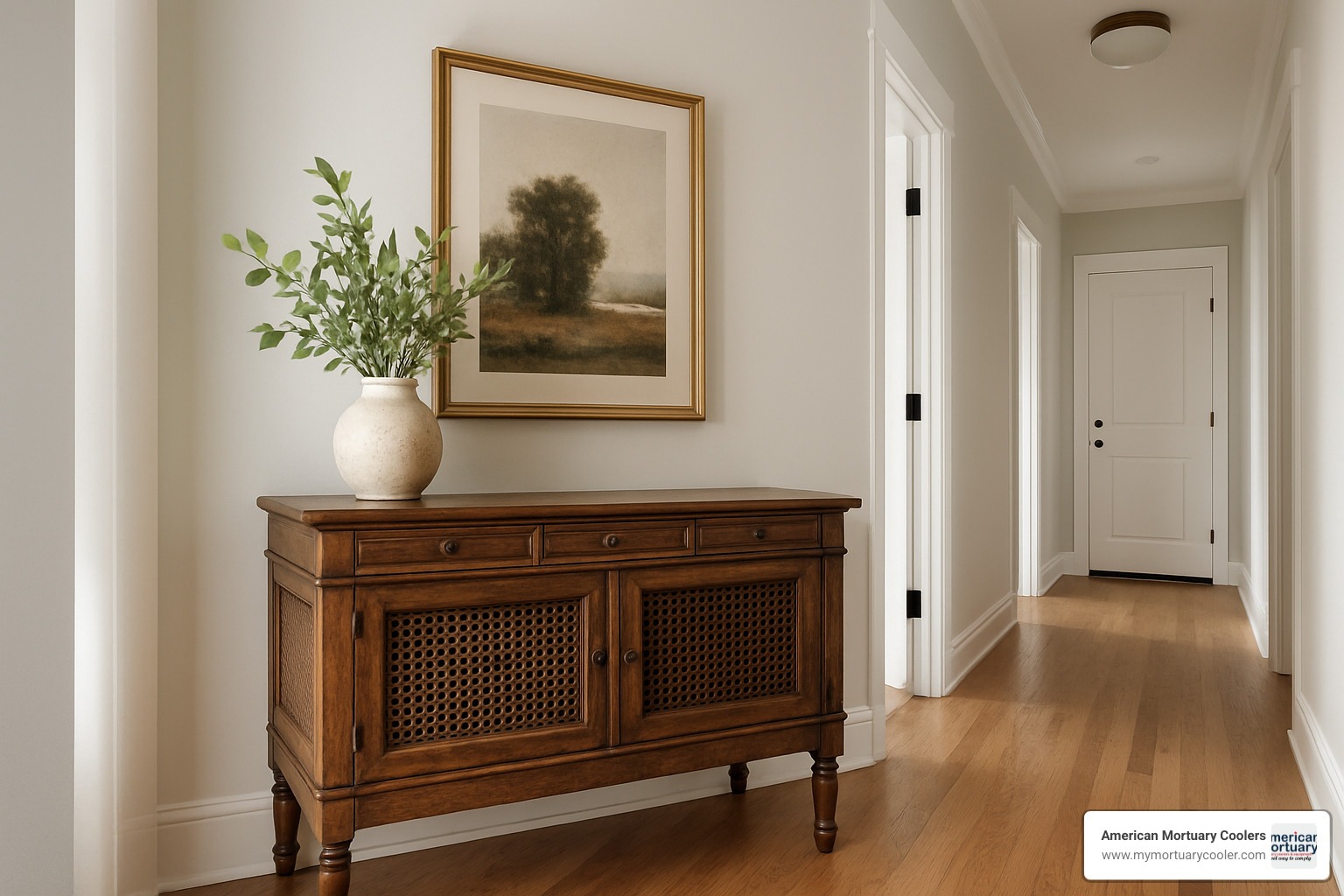
Many collectors face an interesting dilemma: display the table as-is or repurpose it for modern use. Some transform them into console tables or display surfaces, taking advantage of their sturdy construction and conversation-starting appearance. The cane lattice work creates beautiful shadow patterns, and the rich oak patina fits perfectly in homes with period décor.
The cultural impact extends far beyond collecting circles. These tables represent a fundamental shift in how Americans handle death and mourning. When families moved funeral preparations from home parlors to professional funeral homes, they lost direct contact with death rituals that had existed for centuries.
Here's a fascinating linguistic legacy: the term "parlor" largely disappeared from American homes after the 1918 influenza pandemic. Families started calling these rooms "living rooms" instead, deliberately distancing themselves from the death associations. That name change stuck, and most Americans today don't realize their living room was once called a parlor partly because of furniture like cooling tables.
For insights into historical cooling methods, check out the latest research on cooling boards and related preservation techniques.
From Parlors to Funeral Homes: Changing Death Practices
The decline of antique cooling tables perfectly mirrors the rise of professional funeral homes. As embalming techniques became more sophisticated and legally required in many states, families gradually handed over death preparations to trained professionals.
This shift dramatically shortened mourning periods. Victorian families might hold wakes for five to seven days, giving extended family time to travel and properly say goodbye. Modern funerals typically last just two to three days, reflecting our faster-paced society and improved transportation.
The move from homes to funeral establishments improved sanitation and reduced family burdens, but it also created emotional distance. Many grief counselors today note that families who participate more directly in funeral preparations often process loss more effectively than those who remain passive observers.
Modern funeral homes use walk-in coolers and sophisticated refrigeration systems that maintain precise temperatures for weeks. These systems far exceed what ice-based cooling tables could achieve, but they lack the personal touch of family-managed care.
Interestingly, some families are returning to home funeral practices, seeking more intimate and personalized death rituals. While they don't use cooling tables, they appreciate the philosophy behind family-centered mourning that these tables once supported.
For contemporary funeral home cooling solutions, see our comprehensive guide to cooling table options.
Caring for Your Find: Preservation & Display Tips
Proper care ensures these historical artifacts survive for future generations to study and appreciate. The key is understanding that these pieces are over 100 years old and need gentle treatment.
Wood conditioning requires special attention. Use products specifically designed for antique furniture, avoiding modern treatments that might react poorly with original finishes. Test any conditioner on a hidden area first, and apply it sparingly with soft cloths.
Cane re-weaving presents the biggest restoration challenge. Finding craftspeople who understand period-appropriate techniques takes patience, and authentic materials cost significantly more than modern substitutes. However, proper restoration maintains both historical accuracy and long-term value.
Environmental control matters more than most people realize. Maintain humidity levels between 45-55% to prevent wood movement and cracking. Sudden temperature changes can cause joints to loosen or wood to split, so avoid placing tables near heating vents or air conditioning units.
Direct sunlight poses a serious threat to original finishes. UV rays fade stains and weaken wood fibers over decades of exposure. If you display your table near windows, consider UV-filtering film or protective coverings.
For valuable pieces, museum-quality mounting systems distribute weight evenly without stressing original joints. Professional conservation consultation costs money upfront but prevents expensive damage later. These tables survived over a century - proper care ensures they'll last another century for future collectors to enjoy.
At American Mortuary Coolers, we appreciate the engineering ingenuity these antique cooling tables represent. While our modern refrigeration systems use advanced technology, we respect the clever solutions our predecessors developed. Visit our mortuary collection to see how cooling technology has evolved.
Frequently Asked Questions about Antique Cooling Tables
Why do antique cooling tables have cane or hole patterns?
Those distinctive holes and cane patterns weren't just decorative - they were the heart of the entire cooling system. The perforations allowed cold air from ice blocks underneath to flow upward around the body, creating an effective preservation chamber that could maintain proper temperatures for days.
The antique cooling table design also needed to handle moisture. The holes provided essential drainage for condensation from melting ice and any bodily fluids that might occur during extended viewing periods. Without this drainage system, the table would become unsanitary and potentially damage the family's parlor furnishings.
Victorian families appreciated that the cane lattice work served double duty - maintaining the cooling function while looking appropriate for their formal parlors. These weren't crude medical devices, but carefully crafted furniture pieces that respected both practical needs and social expectations.
Here's something fascinating: manufacturers like B.F. Gleason actually arranged the perforation patterns to spell out their company names and patent dates. It was clever advertising that also helps modern collectors identify authentic pieces today.
How can I tell if my folding table is truly an antique cooling table?
The dimensions tell the first part of the story. Authentic antique cooling tables measure 73-76 inches long by 19 inches wide when fully opened. When folded, they should collapse to roughly half that length while keeping the same width - this specific proportion was essential for the portability that traveling morticians required.
Start your investigation by hunting for maker's marks. Look for brass plaques riveted to the frame, especially ones showing patent dates from 1881-1886. These aren't just decorative touches - they're your best proof of authenticity.
The top surface provides another crucial clue. You should see either cane lattice work or perforated wood designed specifically for airflow. If you find a solid wooden or metal top, you're probably looking at an embalming table or some other type of furniture entirely.
Construction quality matters enormously. Original tables show natural aging patterns that develop over 140+ years - things like gradual wood darkening, gentle wear on high-touch areas, and period-appropriate repair work. Reproductions often display artificial distressing or use modern screws and hardware that didn't exist in the 1880s.
Provenance documentation can transform a good find into a great one. Original purchase receipts, family stories passed down through generations, or records from old funeral homes add both authenticity and significant value to your piece.
Are antique cooling tables still used in modern funerals?
Modern funeral practices have moved far beyond ice-based preservation methods. Today's funeral homes use advanced embalming techniques and walk-in refrigeration systems that maintain precise temperatures without the constant maintenance that antique cooling tables required.
Legal requirements have changed too. Most jurisdictions now mandate professional embalming or refrigerated storage for public health reasons, making the old home-based preservation methods impractical even for families who might prefer them.
However, the ceremonial aspects remain meaningful to many families. Some still request extended viewing periods and traditional mourning customs that echo what cooling tables once made possible. Modern funeral homes can honor these preferences using contemporary refrigeration equipment that provides the same results with better safety standards.
At American Mortuary Coolers, we've helped funeral homes across Tennessee, Georgia, Illinois, and beyond transition from historical preservation methods to modern systems. Our custom refrigeration solutions respect traditional practices while meeting today's health and safety requirements.
The fascinating thing is how these old cooling tables paved the way for everything we do today. The same principles of controlled temperature preservation that made those ice-based systems work still guide our modern mortuary cooler designs - we've just replaced the ice with precision refrigeration technology.
Conclusion
Antique cooling tables represent far more than just old furniture - they're windows into a time when families faced death together in their own homes. These clever wooden contraptions solved real problems for grieving families who needed to preserve their loved ones for days of mourning and visiting.
Think about it: someone had to figure out how to keep a body cool using nothing but ice and airflow. The engineers and craftsmen who created these tables weren't just making furniture - they were helping families through their darkest moments with dignity and respect.
Each antique cooling table tells its own story. Maybe it traveled with a country mortician from farm to farm, folding up neatly between house calls. Perhaps it stood in a Victorian parlor while neighbors paid their respects over several days. These tables witnessed countless farewells and final goodbyes.
What strikes me most is how these pieces reflect American ingenuity. Faced with a challenge - preserving bodies without modern refrigeration - inventors like B.F. Gleason created neat solutions that worked beautifully for decades. The folding design, the careful airflow engineering, the thoughtful drainage systems - it all came together in one portable package.
Today, we're fortunate that collectors and museums preserve these important artifacts. They remind us how much funeral practices have changed, and how our ancestors handled death as a natural part of family life rather than something to be hidden away.
At American Mortuary Coolers here in Tennessee, we carry on this tradition of innovation. While our modern refrigeration systems use advanced technology instead of ice blocks, we share the same goal those 19th-century craftsmen had - helping families honor their loved ones with care and dignity.
Our custom mortuary coolers serve funeral homes across all 48 contiguous states, continuing the legacy of reliable preservation equipment that began with those ingenious folding tables over 140 years ago.
Whether you stumble across an antique cooling table at an estate sale or simply appreciate the history they represent, these pieces connected families to their deceased in ways we can barely imagine today. They deserve our respect not just as collectibles, but as reminders of human resilience and the enduring need to say goodbye properly.
For more information about how modern mortuary equipment evolved from these historical pieces, explore our mortuary collection and see how innovation in funeral care continues today.




















